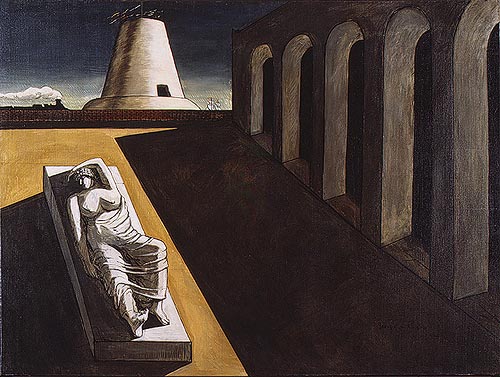.

The Enigma of the Arrival and the Afternoon: Giorgio de Chirico, 1911-1912, oil on canvas, 70 x 86.5 cm (private collection)
It's not so much that leaving
is melancholy
as that.........
.........houses
channel the angst
onto a track
upon which the little train
steams past the factory
What clues may one derive from this sprawl
but blasted
back, bent shoulders
against negative space
............................a wall
that gives way when you touch it
and becomes a door into another room
you can't walk into
a world that way

The Anxious Journey: Giorgio de Chirico, 1913, oil on canvas, 74.3 x 106.7 cm (Museum of Modern Art, New York)

Gare Montparnasse (The Melancholy of Departure): Giorgio de Chirico, 1914, oil on canvas, 140 x 184.5 cm (Museum of Modern Art, New York)

The Anguish of Departure: Giorgio de Chirico, 1914 (Albright-Knox Art Gallery, Buffalo)

Happiness of Returning: Giorgio de Chirico, 1915, oil on canvas (private collection)

Ariadne: Giorgio de Chirico, 1913, oil and graphite on canvas, 135.6 x 180.3 cm; image by RasMarley, 23 February 2011
Tom,
ReplyDelete" bent shoulders
against negative space"
(great to see these de Chiricos next to these words)
1.22
light coming into sky above still black
ridge, streaked sparrow landing on post
in foreground, wave sounding in channel
past only as a past to come,
future which occurred
limits set by object itself,
precise, “geometrical”
silver of sunlight reflected in channel,
lines of white clouds across from point
What a terrific poem.
ReplyDeleteThe poem catches perfectly the tight, irreducible dramas that these paintings are.
ReplyDeletelike that melancholy...
ReplyDeleteWonderful poem complementing de Chirico's paintings.
ReplyDeleteBTW, de Chirico's father was an architect who designed many of the train stations in Greece, which may or may not have had an influence on his son's art--just a passing thought.
Beautiful!
ReplyDeleteAs Vassilis points out, the Greek element in de Chirico's work is important to its understanding. Though of Italian ancestry, the painter was born in Greece -- in Volos, where his father was a railroad construction engineer. The early years of his life spent in Hellas left a lasting impression which can be "read" obliquely in the imagery of his art. He attended the school of fine arts in the Athens Polytechnic. He was seventeen when his father died and his mother moved the family to Munich. Thee young man read Nietzsche there -- another strong influence on the mythological symbolism in his work. A 1908 self-portrait bears as title a quotation from Nietzsche:
ReplyDeleteEt quid amabo nisi quod aenigma est? (1908)
And what shall I love if not the enigma?
In his Meditations of a Painter (1912) de Chirico describes the origins of his "metaphysical town square" thematic:
"One clear autumn afternoon I was sitting on a bench in the middle of the Piazza Santa Croce in Florence. It was of course not the first time I had seen this square. I had just come out of a long and painful intestinal illness, and I was in a nearly morbid state of sensitivity. The whole world, down to the marble of the buildings and fountains, seemed to me to be convalescent. In the middle of the square rises a statue of Dante draped in a long cloak, holding his works clasped against his body, his laurel-crowned head bent thoughtfully earthward. The statue is in white marble, but time has given it a grey cast, very agreeable to the eyes. The autumn sun, warm and unloving, lit the statue and the church facade. Then I had the strange impression I was looking at these things for the first time, and the composition of my picture came to my mind's eye. Now each time I look at that painting I see that moment. Nevertheless the moment is an enigma to me, for it is inexplicable ..."
The picture of which he was speaking:
De Chirico: The Enigma of an Autumn Afternoon (1911)
Less well known than his paintings but equally of interest is de Chirico's mysterious and compelling work of prose fiction, Hebdomeros. The scenes and landscapes in this work might be taken as an alternative text unfolding the remarkable private metaphysics of one of the most interesting artists of the twentieth century. Its long, ornate sentences create a sort of textual web that involve the reader in a way that can only be described as essentially poetic.
“And now, after all that, to end up in this huge glass house, seeking a fugitive ideal in the midst of so many fellow sufferers. This, then, was why he spent whole nights sitting up in bed, his head in his hands, while on the table, between his pipe and tobacco pouch, the candle burned down and dripped into strange shapes. But at such moments it sometimes happened that the back wall opened up like a theater curtain and visions appeared, sometimes terrifying, sometimes sublime or enchanting: there would be the ocean in a storm, with hideous gnomes leering and making threatening gestures on the foaming crests of the waves; and sometimes also you would see a spring landscape of astonishing poetry and peacefulness: green, gentle slopes rising on either side of a path whose edges were shaded by almond trees in blossom; along the path slowly walked a woman dressed all in white, her face thoughtful and serious. 'But it’s nothing,' Hebdomeros, 'compared to what that town was like on summer nights.'"
very informative on de Chirico...
ReplyDeleteI always thought he had information
from the void...